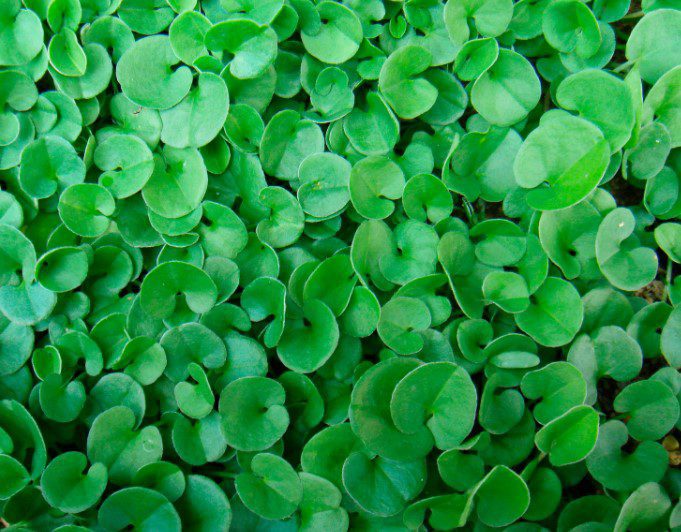Dichondra
Dichondra repens, or kidney weed, in an attractive and useful groundcover. It may be used as a lawn substitute, growing successfully in most climates. Dichondra is a small, prostrate, perennial herb that takes root at the nodes. Preferred positions vary from full sun to 80% shade.
Dichondra has broad, almost circular leaves. It may be mown if it forms a mat that is the required thickness, although it will not tolerate heavy foot traffic. However, plants will soon rejuvenate. It quickly establishes a dense carpet look.
Plants look attractive when planted between pavers. They also grow successfully when planted on steep banks and other less accessible areas of the garden. Plants should be placed no further than 25-30cm apart. Closer planting will result in a faster cover.
Another variety of Dichondra, Dichondra Argenta Silver Falls, is an unusual and attractive specimen for pot culture. The silvery foliage cascades over the edge of the pot in long trailing stems.

This makes it an ideal plant for use in a hanging basket. In ideal conditions, the trailing stems may reach up to 1.5m in length.
Plants are also suitable for growing as a ground cover as it is vigorous and ground-hugging.
Gardeners wanting to grow root vegetable crops in summer should place the seeds directly into the garden beds as, in general, they do not respond well to transplanting.
Best results will be obtained if they are grown in soil that has previously been fertilized for another vegetable type. High-nitrogen fertilizers should be avoided.
Carrots, parsnip, spring onions, cabbage, silverbeet, pumpkin, cucumber, zucchini, beans, celery, and leeks can all be planted this month. However, the earlier part of the month should be selected for planting the latter half dozen varieties.
How to Grow Dichondra
Proper preparation is crucial for growing dichondra plants. It is important to have a weed-free area raked. Dichondra likes well-drained, loose soil that is free of clods and in full sun to partial shade.
The seeds should be sprinkled lightly over the loose soil and watered until it becomes moist but not too wet. Seeds may require watering a few times per day, depending on the area where they are planted.
The seeds can be protected with a thin layer of peat moss to retain moisture. Planting seed is best when temperatures are between 70 and 50 degrees Celsius (21 C.) during daylight hours and 50 to 10 C at night.
This can happen in early spring or even early autumn. Depending on the conditions, the growing dichondra seeds can sprout in 7-14 days.
Dichondra Care
After plants have been established, it is important to water them only once they are established. Give the plants time to dry slightly between waterings. The dichondra can also be used as a lawn substitute.
Most people prefer to mow the dichondra at the height of 1 1/2 inches (4cm). It is better to mow to a height of 1 1/2 inches (4 cm.) For a healthy covering, add 1/2 to 1 pound (227-454g.) of nitrogen each month during the growing seasons.
Pre-emergent weed controls can be applied to the groundcover to control weeds. Dichondra plants will not survive if you use herbicides containing 2-4D.
For best results, remove broadleaf plants by hand.
Interesting Facts on Dichondra
Scientific name: Dichondra argentea `Silver Falls.’
Growth habit: A spreading evergreen perennial with shoots growing to 6 feet long. The leaves are silvery green and rounded to heart-shaped; they grow to an inch in diameter.
Light: Plant in full sunlight to light shade.
Water needs: Tolerates short periods of drought; grows best if watered when the surface soil begins to dry.
Feedings: Apply a 20-20-20 fertilizer every other week to plants in containers during warm weather; feed monthly during cooler weather.
Propagation: Start plants from seed or cuttings.
Ease of culture: Easy.
Hardiness: Hardy.
Major problems: Plantings are sensitive to excessive moisture. Plant in well-drained soil and wait until the surface soil dries to moisten thoroughly.
Pruning: Plantings grow vigorously during warmer weather. Stems might grow out of bounds or out of proportion to other plants. Nip back the long shoots as needed to control unwanted growth.
Uses An attractive cascading plant for hanging containers or planters that survives year-round in local gardens.
Plant alone or mix with annuals or perennials to create eye-catching combinations. The silvery foliage is the most attractive feature, but cream-colored blooms 1/4-inch in diameter also open along the stems.
Silver Falls can be used as a ground cover but might decline during summer because of frequent rains.
Florida native: No; native to Texas and Mexico.























